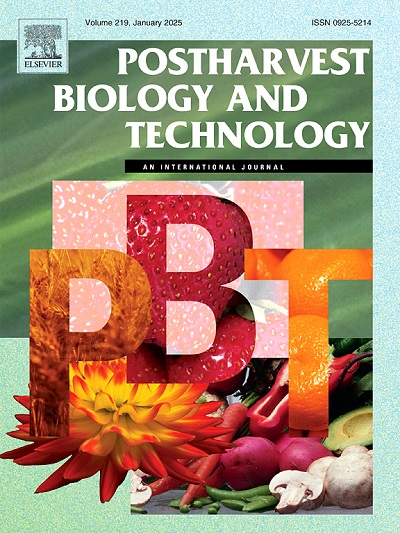比较转录组学和代谢组学分析揭示了酸性电解氧化水在提高龙眼感染龙眼抗病能力中的作用
IF 6.8
1区 农林科学
Q1 AGRONOMY
引用次数: 0
摘要
龙眼果实易受龙眼opsis longanae Chi (P. longanae Chi)侵染而发生品质劣化。本研究发现酸性电解氧化水(AEOW)能有效增强龙眼P. longanae感染后龙眼的抗病能力。与仅处理龙眼假丝虫相比,AEOW加龙眼假丝虫侵染处理降低了龙眼果实病害的严重程度,并保持了较高的商业可接受度。进一步的转录组学分析显示,AEOW + P诱导了与类黄酮和苯丙素生物合成、MAPK信号传导和植物与病原体相互作用途径相关的基因。longanae治疗。此外,代谢组学分析表明,AEOW + P中黄酮类和酚酸含量较高。longanae-treated桂圆。WGCNA和基因-代谢物关联网络显示,AEOW + P增加了多种基因和代谢物。longanae治疗。这些结果表明,AEOW通过提高龙眼抗病基因的表达和增加相关代谢物的积累来抑制龙眼的发病。本文章由计算机程序翻译,如有差异,请以英文原文为准。
Comparative transcriptomic and metabolomic analyses reveal the role of acidic electrolyzed-oxidizing water in enhancing disease resistance in Phomopsis longanae Chi-infected longans
Longan fruit is prone to quality deterioration due to the infection by Phomopsis longanae Chi (P. longanae). This work found that acidic electrolyzed-oxidizing water (AEOW) could effectively enhance disease resistance in P. longanae-infected longans. The treatment of AEOW plus P. longanae infection attenuated fruit disease severity and maintained a higher commercially acceptable fruit of longan as compared to the longans treated only with P. longanae. Further transcriptomic analysis revealed genes associated with flavonoid and phenylpropanoid biosynthesis, MAPK signaling, and plant-pathogen interaction pathways were induced by the AEOW + P. longanae treatment. Moreover, metabolomic analysis showed that higher levels of flavonoids and phenolic acids were found in the AEOW + P. longanae-treated longans. WGCNA and gene-metabolite association networks revealed a variety of genes and metabolites that were increased by the AEOW + P. longanae treatment. These results clarify that AEOW inhibited disease occurrence in P. longanae-inoculated longans by elevating the expression of disease-resistance genes and increasing the accumulation of relevant metabolites.
求助全文
通过发布文献求助,成功后即可免费获取论文全文。
去求助
来源期刊

Postharvest Biology and Technology
农林科学-农艺学
CiteScore
12.00
自引率
11.40%
发文量
309
审稿时长
38 days
期刊介绍:
The journal is devoted exclusively to the publication of original papers, review articles and frontiers articles on biological and technological postharvest research. This includes the areas of postharvest storage, treatments and underpinning mechanisms, quality evaluation, packaging, handling and distribution of fresh horticultural crops including fruit, vegetables, flowers and nuts, but excluding grains, seeds and forages.
Papers reporting novel insights from fundamental and interdisciplinary research will be particularly encouraged. These disciplines include systems biology, bioinformatics, entomology, plant physiology, plant pathology, (bio)chemistry, engineering, modelling, and technologies for nondestructive testing.
Manuscripts on fresh food crops that will be further processed after postharvest storage, or on food processes beyond refrigeration, packaging and minimal processing will not be considered.
 求助内容:
求助内容: 应助结果提醒方式:
应助结果提醒方式:


